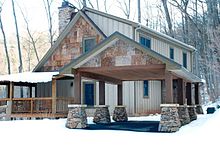Carport
History:
– Term “carport” originates from French term “porte-cochère”
– Frank Lloyd Wright coined the term when using a carport in Usonian home designs
– Carports were used by Prairie School architects in early 1900s
– Term “carport” entered popular jargon in 1939
– W.B. Sloane House in Illinois credited as the first known home with a carport
Solar Canopy:
– Solar canopy carport elevates photovoltaic panels above ground level
– Solar canopies often built over parking lots
– Canopies generate renewable power and protect cars from sun, rain, and snow
– Covered area under canopies can be used for other purposes
– Example of solar canopy at a high school parking lot
Mobile/Enclosed Carport:
– Mobile carports are framed with tubular steel and may have canvas or vinyl covering
– Differentiated from tents by main purpose of housing vehicles
– Can be removed/relocated and typically have accessible front entry
– Used to prevent frost on windshields
– Offer less protection than garages but allow for more ventilation
References:
– Look up “carport” in Wiktionary
– Wikimedia Commons has media related to Carports
– Information on carport integrity policy from Arizona State Historic Preservation Office
– References to Frank Lloyd Wright’s Jacobs House 1936
– References to architectural historian David Gebhard’s work on carports
Japan:
– Carports in Japan are covered structures for vehicle protection
– Offer limited protection from rain and snow
– Can be free-standing or attached to a wall
– Prevent frost on windshields
– Provide less protection than garages but more ventilation
A carport is a covered structure used to offer limited protection to vehicles, primarily cars, from rain and snow. The structure can either be free standing or attached to a wall. Unlike most structures, a carport does not have four walls, and usually has one or two. Carports offer less protection than garages but allow for more ventilation. In particular, a carport prevents frost on the windshield. A "mobile" and/or "enclosed" carport has the same purpose as a standard carport. However, it may be removed/relocated and is typically framed with tubular steel and may have canvas or vinyl type covering which encloses the complete frame, including walls. It may have an accessible front entry or open entryway not typically attached to any structure or fastened in place by permanent means put held in place by stakes. It is differentiated from a tent by its main purpose: to house vehicles and/or motorized equipment (a tent is to shelter people).



